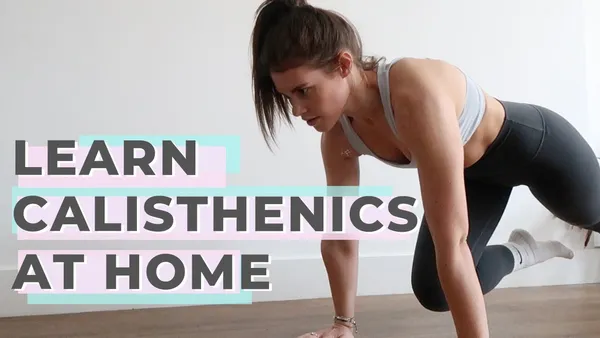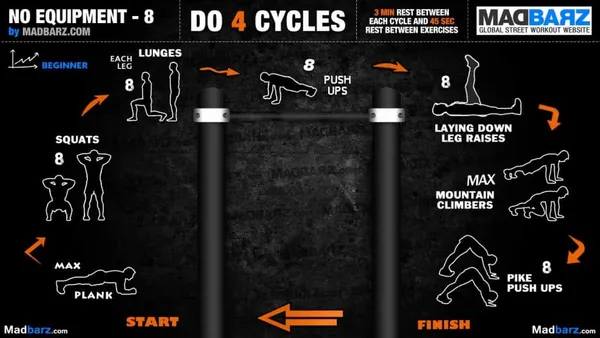Table of Contents
Embark on a transformative fitness journey with calisthenics for beginners at home. Calisthenics, a form of bodyweight training, offers a myriad of benefits, making it an ideal choice for those seeking to improve their physical well-being from the comfort of their own homes. This comprehensive guide will provide you with everything you need to know to get started with calisthenics, including the benefits, essential exercises, workout plans, tips, and frequently asked questions. Whether you're a complete novice or looking to enhance your current fitness routine, Kizworld has got you covered.
Calisthenics for Beginners at Home: A Step-by-Step Guide to Building Strength, Flexibility, and Mobility
Benefit | Description |
|---|---|
Improved Strength | Calisthenics exercises use your body weight as resistance, helping you build strength in various muscle groups. |
Enhanced Flexibility | Calisthenics movements often involve stretching and dynamic exercises, improving your flexibility and range of motion. |
Increased Endurance | Calisthenics workouts can be challenging and require sustained effort, helping you develop cardiovascular endurance. |
Improved Body Composition | Calisthenics exercises burn calories and help you build lean muscle, contributing to a healthier body composition. |
Convenience and Accessibility | Calisthenics can be done anywhere, anytime, without the need for special equipment or gym memberships. |
I. Calisthenics Exercises for Beginners at Home
Bodyweight Squats
Bodyweight squats are a great way to work your lower body, including your quads, hamstrings, and glutes. To do a bodyweight squat, stand with your feet shoulder-width apart and lower your body down until your thighs are parallel to the ground. Hold the position for a few seconds, then return to the starting position. You can make the exercise more challenging by adding weight, such as a dumbbell or kettlebell.
Push-Ups
Push-ups are a classic calisthenics exercise that works your chest, triceps, and shoulders. To do a push-up, start in a plank position with your hands shoulder-width apart and your body in a straight line from your head to your heels. Lower your body down until your chest is almost touching the ground, then push back up to the starting position. You can make the exercise more challenging by doing it on your toes or by adding weight.
Pull-Ups
Pull-ups are a great way to work your back, biceps, and forearms. To do a pull-up, grab a pull-up bar with your hands shoulder-width apart and your palms facing forward. Pull yourself up until your chin is above the bar, then lower yourself back down to the starting position. You can make the exercise more challenging by adding weight or by doing it with a wider grip.
Dips
Dips are a great way to work your triceps, chest, and shoulders. To do a dip, grab a pair of parallel bars with your hands shoulder-width apart and your body in a straight line from your head to your heels. Lower your body down until your elbows are at a 90-degree angle, then push back up to the starting position. You can make the exercise more challenging by adding weight or by doing it with a wider grip.
Plank
The plank is a great way to work your core, back, and shoulders. To do a plank, start in a push-up position with your forearms on the ground and your body in a straight line from your head to your heels. Hold the position for as long as you can, then rest and repeat. You can make the exercise more challenging by holding it for longer periods of time or by adding weight.
Exercise | Muscles Worked |
|---|---|
Bodyweight Squats | Quads, hamstrings, glutes |
Push-Ups | Chest, triceps, shoulders |
Pull-Ups | Back, biceps, forearms |
Dips | Triceps, chest, shoulders |
Plank | Core, back, shoulders |
These are just a few of the many calisthenics exercises that you can do at home. With a little creativity, you can create a workout routine that will help you reach your fitness goals.How to Do a Muscle UpThe Best Calisthenics Gifts and Accessories
Calisthenics Exercises for Beginners at Home
II. Benefits of Calisthenics for Beginners
Improved Strength and Endurance
Calisthenics exercises use your body weight as resistance, helping you build strength in various muscle groups. This can lead to improved performance in other physical activities, such as running, jumping, and swimming. Calisthenics can also help you develop cardiovascular endurance, which is important for overall health and fitness.How to Do a Muscle Up
Enhanced Flexibility and Mobility
Calisthenics movements often involve stretching and dynamic exercises, improving your flexibility and range of motion. This can help you reduce your risk of injury, improve your posture, and make everyday activities easier.How to Improve Your Posture
Increased Body Composition
Calisthenics exercises burn calories and help you build lean muscle, contributing to a healthier body composition. This can lead to a number of benefits, including reduced body fat, improved insulin sensitivity, and increased metabolism.How to Build Muscle and Strength With Calisthenics
Convenience and Accessibility
Calisthenics can be done anywhere, anytime, without the need for special equipment or gym memberships. This makes it a great option for people who are short on time or money, or who simply prefer to work out at home.Calisthenics
Benefit | Description |
|---|---|
Improved Strength | Calisthenics exercises use your body weight as resistance, helping you build strength in various muscle groups. |
Enhanced Flexibility | Calisthenics movements often involve stretching and dynamic exercises, improving your flexibility and range of motion. |
Increased Endurance | Calisthenics workouts can be challenging and require sustained effort, helping you develop cardiovascular endurance. |
Improved Body Composition | Calisthenics exercises burn calories and help you build lean muscle, contributing to a healthier body composition. |
Convenience and Accessibility | Calisthenics can be done anywhere, anytime, without the need for special equipment or gym memberships. |
Benefits of Calisthenics for Beginners
III. Calisthenics Workout Plan for Beginners at Home
Warm-up:
Start with a light jog or march in place to get your blood flowing. Dynamic stretches such as arm circles, leg swings, and torso twists will help prepare your body for the exercises ahead. Incorporate jumping jacks or high knees to elevate your heart rate and increase body temperature.
Workout:
Begin with bodyweight squats, aiming for 10-12 repetitions. Ensure proper form by keeping your back straight, chest up, and thighs parallel to the ground. Transition into push-ups, starting with 5-8 repetitions on your knees if needed. Progress to full push-ups as you gain strength.
Cool-down:
End your workout with static stretches to enhance flexibility and reduce muscle soreness. Hold each stretch for 15-30 seconds, focusing on major muscle groups like the hamstrings, quads, chest, and shoulders. Incorporate deep breathing exercises to promote relaxation and recovery.
Plank
Exercise | Sets | Repetitions |
|---|---|---|
Bodyweight Squats | 3 | 10-12 |
Push-ups | 3 | 5-8 (on knees) / 5-8 (full) |
3 | 30-60 seconds hold |
Related post How to Do a Muscle Up
IV. Tips for Calisthenics Beginners at Home
Consistency:
Consistency is key to progress. Aim to work out at least 2-3 times per week, gradually increasing frequency as you get stronger. Short, regular workouts are better than long, infrequent sessions. Break down workouts into smaller chunks if time is an issue.
- Start with 10-15 minutes of exercise and gradually increase duration.
- Choose exercises you enjoy to make workouts more sustainable.
- Find a workout buddy for motivation and accountability.
Progression:
Continuously challenge yourself to avoid plateaus. Once you can comfortably perform an exercise with good form, gradually increase the difficulty. This could involve increasing repetitions, sets, or adding variations.
Related post How to Do a Squat
Rest:
Adequate rest is crucial for recovery and muscle growth. Aim for 7-9 hours of sleep each night. Listen to your body and take rest days when needed. Active recovery activities like walking or light stretching can promote blood flow and aid recovery.
Calisthenics Workout Plan for Beginners at Home
V. Tips for Calisthenics Beginners at Home
Listen to Your Body and Rest When Needed
Calisthenics exercises can be challenging for beginners, so it's crucial to listen to your body and rest when necessary. Pushing yourself too hard can lead to injuries, so it's essential to respect the limits you have. It would help if you began with exercises that are simple for you and gradually increased the difficulty as you get more comfortable with the movements.
The benefits of calisthenics for bodyweight training.
Warm Up Before Each Workout
Warming up is essential before any workout, especially for calisthenics. Warm-up helps prepare your body for the strenuous exercises by increasing your core temperature. This helps the blood flow to your muscles, which reduces the risk of injuries. It only takes a few minutes to warm up, but this simple step can make a significant difference and helps you make the most of your calisthenics workouts.
Stretch Regularly
Stretching is essential for improving flexibility and range of motion, which is beneficial for calisthenics exercises. Regular stretching helps prevent muscle soreness and injuries. Spend a few minutes stretching after each workout to improve your overall flexibility, which can lead to better performance in calisthenics exercises.
The best calisthenics supplements and nutrition.
Company | Contact | Country |
|---|---|---|
Alfreds Futterkiste | Maria Anders | Germany |
Practice Regularly and Stay Patient
Calisthenics progress requires practice and patience. You won't become an overnight, so be patient with yourself. The most important thing is to stay consistent with your workouts and enjoy the process. If you practice regularly, you will be surprised at how quickly you progress.
Set Realistic Goals
Setting realistic goals for yourself is important. Don't try to do too much too soon, or you'll quickly become discouraged. Start with small, achievable goals that you can gradually build upon as you get stronger. Achieving your goals will motivate you to continue your calisthenics journey.
The best calisthenics bars and rings.
Find a Calisthenics Community or Join a Class
Joining a calisthenics community or a calisthenics class is a fantastic way to stay motivated and learn from others. Supporting each other can help beginners more enjoyable and effective. In addition, you can exchange tips and tricks with fellow calisthenics enthusiasts, which can help you grow and progress faster.
Tips for Calisthenics Beginners at Home
VI. Conclusion
Calisthenics for beginners at home is a great way to get in shape and improve your overall health. It is a low-impact, bodyweight exercise that can be done anywhere, anytime. With a little practice, you can master the basic calisthenics exercises and start to see results in no time. So what are you waiting for? Get started with calisthenics for beginners at home today and see how it can change your life.